ABS BMW MOTORRAD K 1200 S 2004 Rider's Manual (in English)
[x] Cancel search | Manufacturer: BMW MOTORRAD, Model Year: 2004, Model line: K 1200 S, Model: BMW MOTORRAD K 1200 S 2004Pages: 162, PDF Size: 2.99 MB
Page 52 of 162
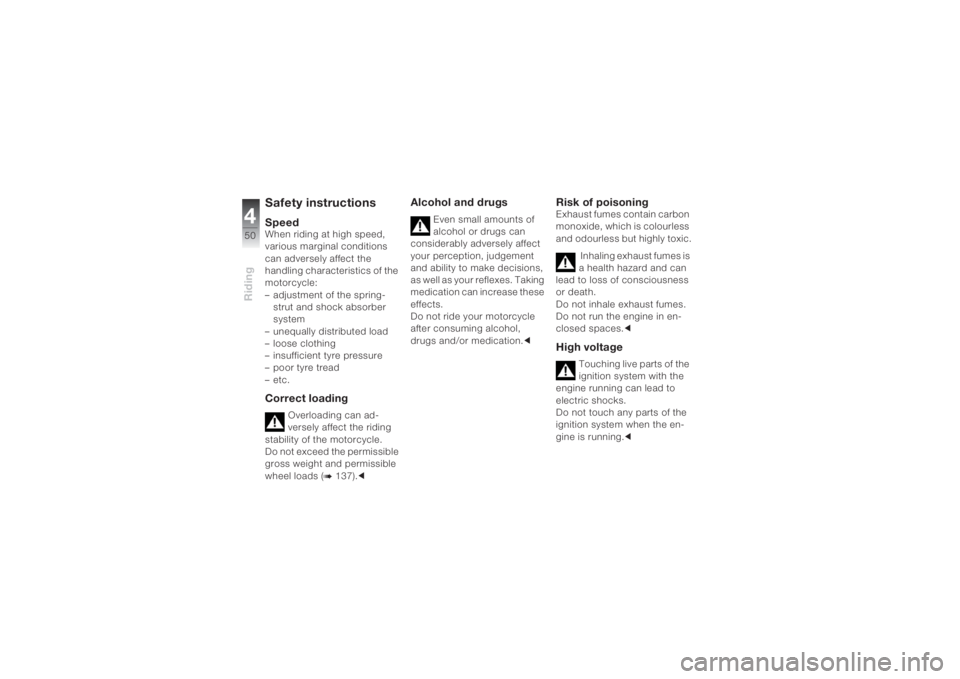
Riding450
Safety instructionsSpeedWhen riding at high speed,
various marginal conditions
can adversely affect the
handling characteristics of the
motorcycle:
– adjustment of the spring-
strut and shock absorber
system
– unequally distributed load
– loose clothing
– insufficient tyre pressure
– poor tyre tread
–etc.Correct loading
Overloading can ad-
versely affect the riding
stability of the motorcycle.
Do not exceed the permissible
gross weight and permissible
wheel loads (
b 137).c
Alcohol and drugs
Even small amounts of
alcohol or drugs can
considerably adversely affect
your perception, judgement
and ability to make decisions,
as well as your reflexes. Taking
medication can increase these
effects.
Do not ride your motorcycle
after consuming alcohol,
drugs and/or medication.c
Risk of poisoningExhaust fumes contain carbon
monoxide, which is colourless
and odourless but highly toxic.
Inhaling exhaust fumes is
a health hazard and can
lead to loss of consciousness
or death.
Do not inhale exhaust fumes.
Do not run the engine in en-
closed spaces.cHigh voltage
Touching live parts of the
ignition system with the
engine running can lead to
electric shocks.
Do not touch any parts of the
ignition system when the en-
gine is running.c
Page 54 of 162

Riding452
Safety checkPrior to every journeyUse the following checklist to
check important functions,
settings and wear limits before
starting to ride. Checklist–Brakes (
b 93)
– Brake fluid level (
b 91)
– Clutch function (b 93)
– Clutch fluid level (b 93)
– Warning and telltale lights
(
b 18)
– Shock absorber setting
(b 44, 46) and spring
preload (
b 47)
–Rims (
b 94), tread depth
(
b 94) and tyre pressure
(b 47)
– Load, gross weight (
b 137)
– Secure luggage systemAt regular intervals:
– Engine oil level (every time
you refuel) (
b 86)
– Brake pads (every second/
third time you refuel)
(
b 90, 91)
Making your first tripSafe handling of your
motorcycleEach motorcycle has its 'own
life' that you have to get used
to:
– Acceleration capability
– Road holding
– Cornering characteristics
–Braking power
The engine also has to be
run in during the first 1,000 km
(b 58).You will find information on
BMW Integral ABS from
(
b 69) onwards.
BMW Integral ABS incor-
porates braking power
assistance, so that braking
power is significantly higher
than with conventional brake
systems. Especially when
cornering, unintentionally hard
braking can lead to dangerous
situations.
Practice braking with
BMW Integral ABS in safe
situations.c
Page 55 of 162
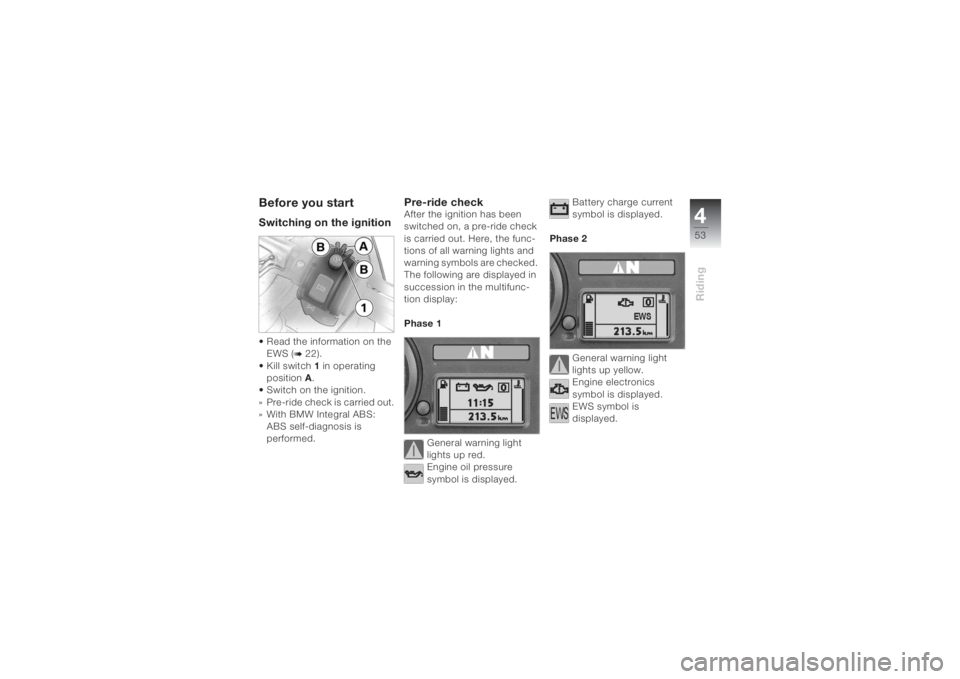
453Riding
Before you startSwitching on the ignition• Read the information on the
EWS (
b 22).
• Kill switch1 in operating
positionA.
• Switch on the ignition.
» Pre-ride check is carried out.
» With BMW Integral ABS:
ABS self-diagnosis is
performed.
Pre-ride checkAfter the ignition has been
switched on, a pre-ride check
is carried out. Here, the func-
tions of all warning lights and
warning symbols are checked.
The following are displayed in
succession in the multifunc-
tion display:
Phase 1
General warning light
lights up red.
Engine oil pressure
symbol is displayed.Battery charge current
symbol is displayed.
Phase 2
General warning light
lights up yellow.
Engine electronics
symbol is displayed.
EWS symbol is
displayed.
Page 56 of 162

Riding454
Phase 3
Lamps defective warning
light is displayed.
If one of the warning
lights or a warning
symbol cannot be displayed,
a function fault in the corre-
sponding system cannot be
displayed.
Pay attention to the displays
for all lights and symbols.cIf one of the lights or symbols
is not displayed:
• Have the fault remedied as
soon as possible by a spe-
cialist workshop, preferably
an authorised BMW motor-
cycle dealer.
After completion of the pre-
ride check, the current values
are displayed.
If the engine is started
during the pre-ride
check, the pre-ride check is
cancelled.c
With BMW Integral ABS, the
ABS self-diagnosis is also
carried out.
ABS self-diagnosisThe ABS warning light is
shown in one of the following
three variants depending on
the country:
The operational readiness of
the BMW Integral ABS is
checked by the self-diagnosis
and starting-off test (
b 58).
Self-diagnosis is performed
automatically when you switch
on the ignition.
Self-diagnosis is not per-
formed unless both brake
levers are in their fully released
Page 57 of 162

455Riding
positions. Before conclusion
of the self-diagnosis, only
residual braking function
(b 71) is available.
• Release the brake lever.
• Switch on the ignition.
Phase 1
General warning light
lights up.
ABS warning light flashes
4 times per second.
Self-diagnosis is carried out.
Phase 2
ABS warning light flashes
once per second.
Self-diagnosis is complete. The warning light goes out
after completion of the start-
ing-off test (
b 58).
If the ignition is switched
on with the brake lever
operated and then the engine
is started and the motorcycle
moves off immediately, the
BMW Integral ABS is still in the
residual braking function
(
b 71). The self-diagnosis is
carried out as soon as the
brake lever is released com-
pletely for the first time. During
this period, neither the ABS
function nor the braking power
assistance is available.
When you start the engine,
wait until the ABS self-diagno-
sis has been carried out.cStarting on gradients:
Switch on the ignition
with the gear engaged, clutch
lever released and brake lever
released. Then press the
brake, press the clutch and
start the engine.c
Side-standIf the side stand is extended
and a gear is engaged, you
cannot start the motorcycle.
If the motorcycle has been
started in neutral and a gear is
then engaged while the side
stand is extended, the engine
switches off.
Page 60 of 162

Riding458
RidingABS starting-off testThe ABS warning light is
shown in one of the following
three variants depending on
the country:
ABS warning light flashes
once per second.
After starting off, the BMW
Integral ABS checks the ABS
sensors. The ABS warning
light then goes out and the
BMW Integral ABS is active.
Running in• During the running-in period,
ride in frequently changing
load and engine speed
ranges.
• Choose hilly routes with a
large number of corners, but
avoid motorways where
possible.
Exceeding the running-in
speeds increases engine
wear.
Adhere to the guide values
described below.cUp to 1,000 km distance
ridden• Engine speed max.
7,000 rpm.
• No full-load acceleration.
• At full load, avoid low engine
speeds. • After 500 – 1,200 km be
sure to have the first
inspection carried out.
Brake padsNew brake pads must "bed
down" and therefore do not
achieve their optimum friction
levels during the first 500 km.
The reduction in braking effi-
ciency can be compensated
for by exerting greater pres-
sure on the brake lever.
New brake pads can
considerably lengthen
the braking distance.
Brake carefully and safely.
Avoid braking sharply.c
Page 65 of 162
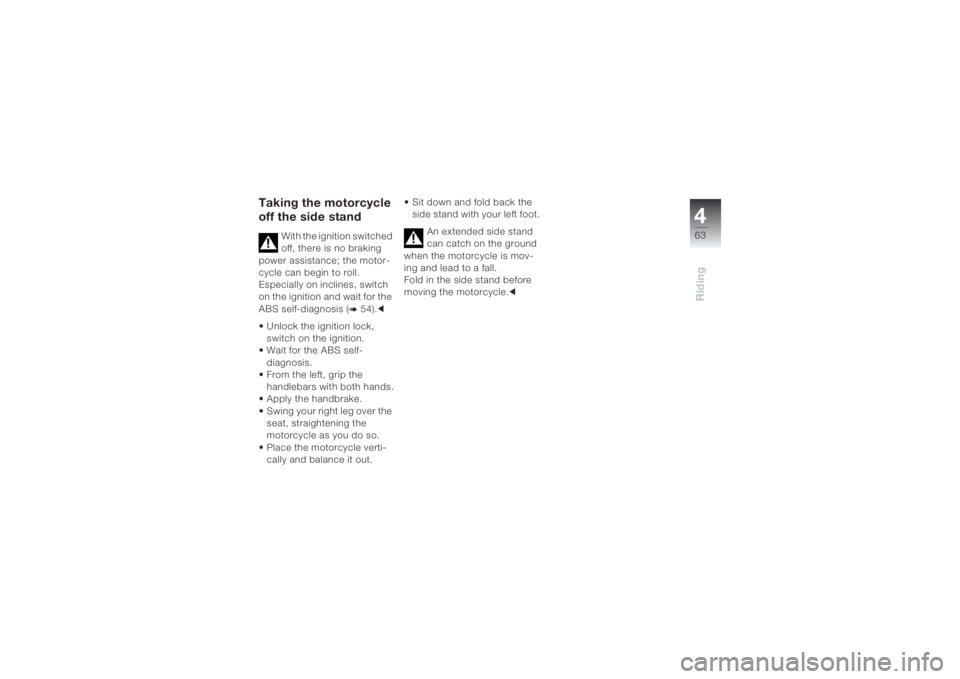
463Riding
Taking the motorcycle
off the side stand
With the ignition switched
off, there is no braking
power assistance; the motor-
cycle can begin to roll.
Especially on inclines, switch
on the ignition and wait for the
ABS self-diagnosis (
b 54).c
• Unlock the ignition lock,
switch on the ignition.
•Wait for the ABS self-
diagnosis.
• From the left, grip the
handlebars with both hands.
• Apply the handbrake.
• Swing your right leg over the
seat, straightening the
motorcycle as you do so.
• Place the motorcycle verti-
cally and balance it out.• Sit down and fold back the
side stand with your left foot.
An extended side stand
can catch on the ground
when the motorcycle is mov-
ing and lead to a fall.
Fold in the side stand before
moving the motorcycle.c
Page 69 of 162
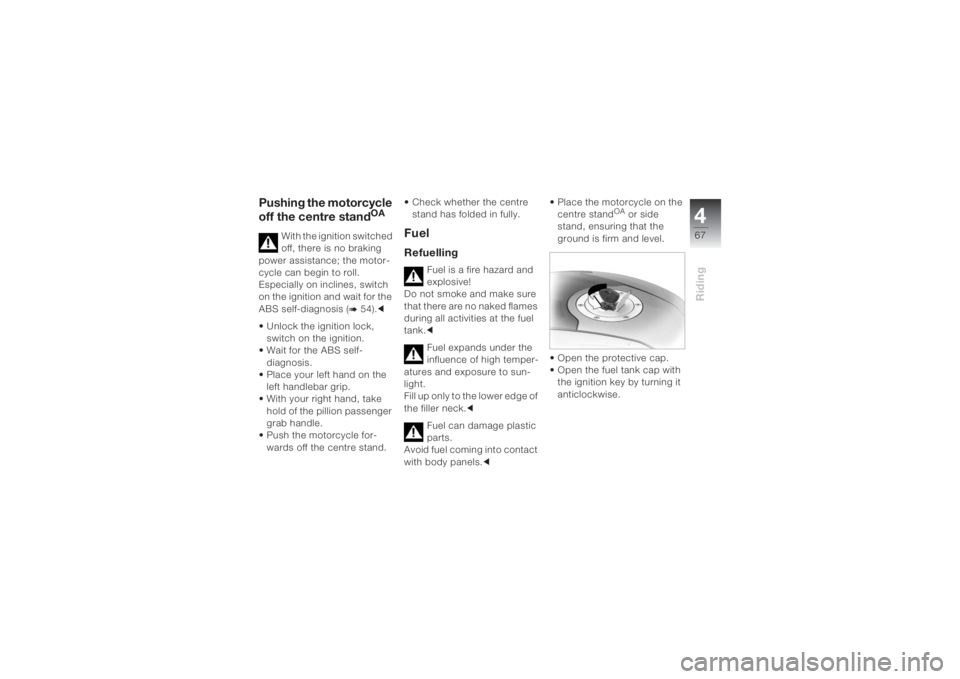
467Riding
Pushing the motorcycle
off the centre stand
OA
With the ignition switched
off, there is no braking
power assistance; the motor-
cycle can begin to roll.
Especially on inclines, switch
on the ignition and wait for the
ABS self-diagnosis (
b 54).c
• Unlock the ignition lock,
switch on the ignition.
•Wait for the ABS self-
diagnosis.
• Place your left hand on the
left handlebar grip.
• With your right hand, take
hold of the pillion passenger
grab handle.
• Push the motorcycle for-
wards off the centre stand.• Check whether the centre
stand has folded in fully.
Fuel Refuelling
Fuel is a fire hazard and
explosive!
Do not smoke and make sure
that there are no naked flames
during all activities at the fuel
tank.c
Fuel expands under the
influence of high temper-
atures and exposure to sun-
light.
Fill up only to the lower edge of
the filler neck.c
Fuel can damage plastic
parts.
Avoid fuel coming into contact
with body panels.c• Place the motorcycle on the
centre stand
OA or side
stand, ensuring that the
ground is firm and level.
• Open the protective cap.
• Open the fuel tank cap with
the ignition key by turning it
anticlockwise.
Page 71 of 162
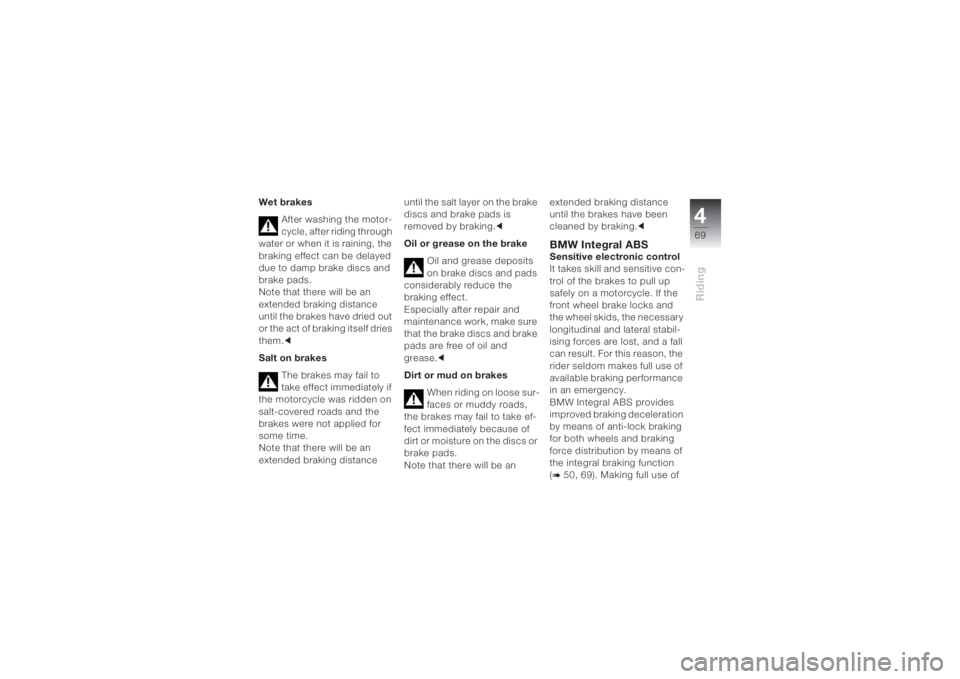
469Riding
Wet brakes
After washing the motor-
cycle, after riding through
water or when it is raining, the
braking effect can be delayed
due to damp brake discs and
brake pads.
Note that there will be an
extended braking distance
until the brakes have dried out
or the act of braking itself dries
them.c
Salt on brakes
The brakes may fail to
take effect immediately if
the motorcycle was ridden on
salt-covered roads and the
brakes were not applied for
some time.
Note that there will be an
extended braking distance until the salt layer on the brake
discs and brake pads is
removed by braking.c
Oil or grease on the brake
Oil and grease deposits
on brake discs and pads
considerably reduce the
braking effect.
Especially after repair and
maintenance work, make sure
that the brake discs and brake
pads are free of oil and
grease.c
Dirt or mud on brakes
When riding on loose sur-
faces or muddy roads,
the brakes may fail to take ef-
fect immediately because of
dirt or moisture on the discs or
brake pads.
Note that there will be an extended braking distance
until the brakes have been
cleaned by braking.c
BMW Integral ABSSensitive electronic control
It takes skill and sensitive con-
trol of the brakes to pull up
safely on a motorcycle. If the
front wheel brake locks and
the wheel skids, the necessary
longitudinal and lateral stabil-
ising forces are lost, and a fall
can result. For this reason, the
rider seldom makes full use of
available braking performance
in an emergency.
BMW Integral ABS provides
improved braking deceleration
by means of anti-lock braking
for both wheels and braking
force distribution by means of
the integral braking function
(b 50, 69). Making full use of
Page 72 of 162
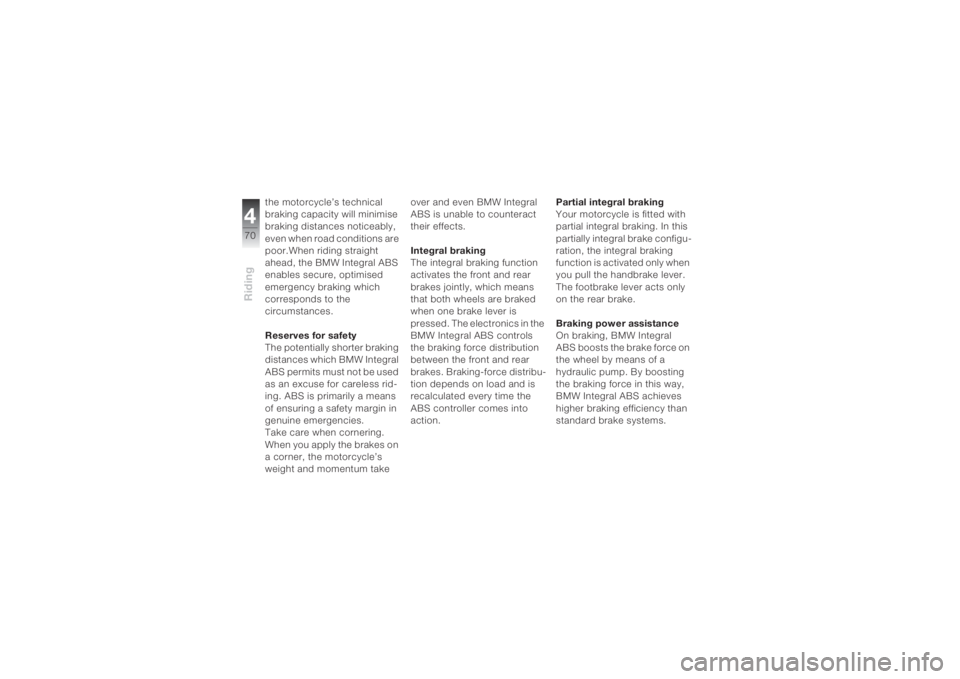
Riding470
the motorcycle’s technical
braking capacity will minimise
braking distances noticeably,
even when road conditions are
poor.When riding straight
ahead, the BMW Integral ABS
enables secure, optimised
emergency braking which
corresponds to the
circumstances.
Reserves for safety
The potentially shorter braking
distances which BMW Integral
ABS permits must not be used
as an excuse for careless rid-
ing. ABS is primarily a means
of ensuring a safety margin in
genuine emergencies.
Take care when cornering.
When you apply the brakes on
a corner, the motorcycle’s
weight and momentum take over and even BMW Integral
ABS is unable to counteract
their effects.
Integral braking
The integral braking function
activates the front and rear
brakes jointly, which means
that both wheels are braked
when one brake lever is
pressed. The electronics in the
BMW Integral ABS controls
the braking force distribution
between the front and rear
brakes. Braking-force distribu-
tion depends on load and is
recalculated every time the
ABS controller comes into
action. Partial integral braking
Your motorcycle is fitted with
partial integral braking. In this
partially integral brake configu-
ration, the integral braking
function is activated only when
you pull the handbrake lever.
The footbrake lever acts only
on the rear brake.
Braking power assistance
On braking, BMW Integral
ABS boosts the brake force on
the wheel by means of a
hydraulic pump. By boosting
the braking force in this way,
BMW Integral ABS achieves
higher braking efficiency than
standard brake systems.